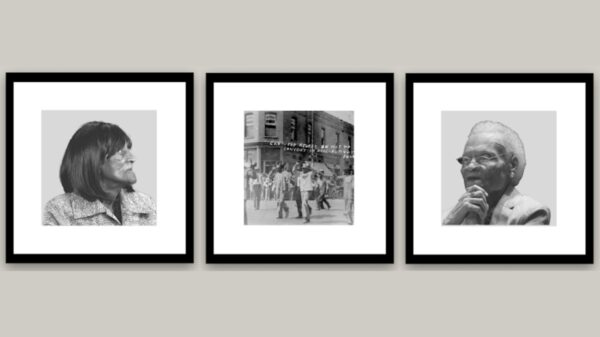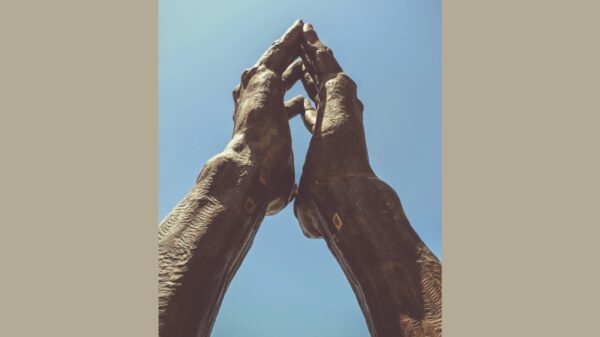By: Justice B. Hill
NABJ Black News & Views
https://blacknewsandviews.com/
David Raterman, a white writer and book editor who lives in Fort Lauderdale, Florida, walked into an unfamiliar world last year. He had heard and read stories about the 1921 massacre in Tulsa, Oklahoma, more than 100 years ago.
But until Raterman went to Greenwood Rising, an interactive museum that keeps the story fresh, he didn’t know the scope of the slaughter.
“I’m a well-read student of history,” he said. “It simply not a subject many Americans know about.”
Raymond Doswell aims to change that.
Doswell, who gave Raterman a tour last year of Greenwood Rising, just celebrated his second anniversary as executive director of the museum, which keeps the horrific history of the senseless murder of Black people alive.
To do that, Doswell knows he must do one thing: Think big.
He is.
“Our primary goals and vision are to try to help end racial violence and create generational wealth,” said Doswell, a public historian. “The way we do it as a history center is through programming — to be able to discuss … these things.”


He has plenty to discuss too. The racial killings in Tulsa wiped out an entire community of prosperous Black residents. White lynch mobs destroyed restaurants, pool halls, churches and theaters in Greenwood, and burned 1,250 homes, killing an estimated 30 to 300 people.
RELATED: Curator to head museum focused on Tulsa Race Massacre, Greenwood
According to the Oklahoma Historical Society, here are the specifics of what lead to the slaughter:
On May 30, 1921, Dick Rowland went to his job as a shoe shiner in a downtown Tulsa office building. Segregation law prevented Dick Rowland from using the restroom in his building, so he was forced to use the restroom on the top floor of a nearby building —the closest “Colored” restroom. Elevators in the 1920s required operators, and women often filled these jobs. On this day Sarah Page, a white woman, was operating the elevator when Roland came to the building to use the upstairs restroom. When the elevator reached the first floor, a clerk heard Page scream and saw Rowland run out of the building. The clerk reported the incident to the police. The police, after speaking with Page, apparently did not consider investigating the incident or apprehending Rowland a high priority. They waited until the next day to arrest Rowland.
Newsboys for the afternoon Tulsa World then triggered the violence as they sold newspapers with shouts of “A Negro assaults a white girl!”

Greenwood Rising recounts this story, and it provides visitors a piece of American history, a history woven with narratives that often show America at its worst, said Doswell, who has a doctorate in history.
People might forgive what happened in the 35-block Greenwood neighborhood over a century ago, he said. But they can’t afford to forget what happened.
The story of Black Wall Street isn’t just a Tulsa story; it isn’t just an American story; it’s a global story of man’s inhumanity to man, which has played out elsewhere in countries like Armenia, Rwanda, South Africa.
“We’re a national, international enterprise,” Doswell said of Greenwood Rising.

He’s spent his first two years at the museum stabilizing its operations, adding staff and putting people in key roles to complement what he’s strived to do as its executive director. Those men and women have helped Doswell expand his outreach beyond Tulsa and Oklahoma.
In cobbling together his plans, Doswell said the museum, which cost nearly $20 million to build, has developed partnerships with local organizations. Greenwood Rising, which has had more than 250,000 visitors since it opened, has attracted people from Eastern Europe, from Africa and from all corners of the United States to its interactive displays that are essential to the telling of the Black Wall Street story.
“Certain folks are noticing that the story is important,” he said. “The story might be local, but it has a bigger outreach … it has long tentacles in terms of understanding America and world history.”
As he pushes the story beyond the city’s borders, Doswell faces a challenge: to grow thoughtfully while maintaining the institution’s core mission. As the city he calls home grapples with its past and charts its future, Greenwood Rising stands as both a memorial to history and a catalyst for change. Yet it does have a horrific past it must contend with.
The massacre destroyed the lives of hundreds of Black families, and of those people who survived the slaughter, only two remain: Lessie Benningfield Randle, 109; and Viola Fletcher, 110.
Are Randle, Fletcher and heirs of Black Wall Street victims owed something for what they lost?

For certain, they are owed the dignity of having their story remain etched into U.S. history, but if they’re asking for reparations (or restitution), the opinions are mixed, Doswell said. The state Supreme Court has denied reparations, but the fight for justice continues — in the legal world and in the court of public opinion.
“We’re not DEI, but we are, you know,” Doswell said. “Maybe that’s how some folks see us, in terms of either on the corporate level and the philanthropic level, of what we do and how we fit maybe in what they see, how we can contribute to what they need to do.”
In a year, Greenwood Rising will celebrate its fifth birthday, and Doswell and his staff are moving to make the observance unforgettable.
His plans include a speakers and authors series at the museum, he said. He intends to collaborate with universities and various groups around the city and state to raise its profile. He’s also taking an aggressive approach to growing membership to the museum, particularly among locals. As Doswell put it, he wants to amplify discussion about the massacre.
He wants locals to know Greenwood Rising is their story.
“The museum, obviously, is a centerpiece, but the series that I talked about I hope will reach thought leaders outside of Tulsa,” he said. “All of these are significant because they didn’t exist two years ago.”
Yet what has been most significant, he said, was that Greenwood Rising has, since his arrival, become an indispensable part of Tulsa. While its reach is national, Doswell knows Tulsans need to visit often.
“On some levels, we’re still a rather small museum. We’re not a museum that is able to help with research, but we have an opportunity to really raise the profile of teaching the story of Greenwood.”
How do you do that? he’s asked.
“Think big,” Doswell replied.
Raterman hopes he does.
“Before visiting Greenwood Rising, I knew very little about the Tulsa massacre,” he said. “It was a profound, sad, infuriating and ultimately important visit. Everyone should know about that tragic event in American history.”








You must be logged in to post a comment Login